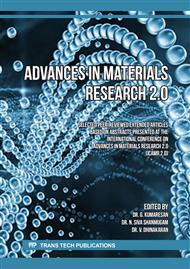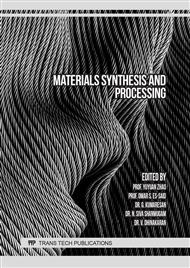[1]
Jani, S. P., Jose, A. S., Rajaganapathy, C., & Khan, M. A. (2022). A polymer resin matrix modified by coconut filler and its effect on structural behavior of glass fiber-reinforced polymer composites. Iranian Polymer Journal, 1-11.
DOI: 10.1007/s13726-022-01042-y
Google Scholar
[2]
Asim, M., Paridah, M. T., Chandrasekar, M., Shahroze, R. M., Jawaid, M., Nasir, M., & Siakeng, R. (2020). Thermal stability of natural fibers and their polymer composites. Iran. Polym. J, 29, 625-648.
DOI: 10.1007/s13726-020-00824-6
Google Scholar
[3]
Kushvaha, V., Kumar, S. A., Madhushri, P., & Sharma, A. (2020). Artificial neural network technique to predict dynamic fracture of particulate composite. J. Compos. Mater, 54(22): 3099-3108.
DOI: 10.1177/0021998320911418
Google Scholar
[4]
Madhu, P., M. R. Sanjay, Anish Khan, Ahmed Al Otaibi, Salma Ahmed Al-Zahrani, S. Pradeep, B. Yogesha, Pawinee Boonyasopon, and Suchart Siengchin. (2020), Hybrid Effect of PJFs/E-glass/Carbon Fabric Reinforced Hybrid Epoxy Composites for Structural Applications. J. Nat. Fibers 1-11.
DOI: 10.1080/15440478.2020.1848724
Google Scholar
[5]
S. P. Jani, A. Senthil Kumar, M. Adam Khan, S. Sajith, and A. Saravanan, (2020), J. Nat. Fibers,.
Google Scholar
[6]
Bandyopadhyay-Ghosh, S., Ghosh, S.B., Sain, M.,The use of biobased nanofibres in composites. In: Faruk, O., Sain, M. (Eds.), Biofiber Reinforcements in Composite Materials. Elsevier, Sawston, Cambridge, (2015) p.571–647. http://dx.doi.org/10.1533/ 9781782421276.5.571.
DOI: 10.1533/9781782421276.5.571
Google Scholar
[7]
Abraham, E., Deepa, B., Pothan, L.A., Jacob, M., Thomas, S., Cvelbar, U., Anandjiwala, R.., Extraction of nanocellulose fibrils from lignocellulosic fibres: a novel approach. Carbohydr. Polym. (2011) 86, 1468–1475. http://dx.doi.org/10.1016/j.carbpol.2011.06. 034.
DOI: 10.1016/j.carbpol.2011.06.034
Google Scholar
[8]
Tengku F. Z. H., Faisal A. H., Salmah and Iqmal Tahir, 'The Effect of Acetic Acid on Properties of Coconut Shell Filled Low Density Polypropylene Composites', International journal of Chemistry. (2010)10 (3), 334 -340.
DOI: 10.22146/ijc.21439
Google Scholar
[9]
Jani S.P., Kumar A.S, Kahn M.A., and Kumar M.U., Machinability of fiber reinforced composite with and without filler as reinforcement,, Material and Manufacturing Process. (2016) Vol. 31, 1393-99.
Google Scholar
[10]
P. R. Ross, J. Paramanandham, P. Thenmozhi, K. S. Abbiramy, M. Muthulingam, Int. J. Rec. Environ. Sci. Technol. 2(2), 45-47 (2012).
Google Scholar
[11]
Jani, S. P., Sajin, J. B., Godwin, G., & Ananthapuri, S. A. (2019). Mechanical behaviour of coir and wood dust particulate reinforced hybrid polymer composites.
Google Scholar
[12]
Sujin Jose, A., Athijayamani, A., Jani, S. P., Stalany, M. V., & Khan, A. M. (2022). Investigations on Mechanical Properties of Bio-Waste Micro Particles Reinforced Phenol Formaldehyde Composites. Archives of Metallurgy and Materials, 67.
DOI: 10.1016/j.matpr.2020.07.360
Google Scholar
[13]
Barbière, R., Touchard, F., Chocinski-Arnault, L., & Mellier, D. (2020). Influence of moisture and drying on fatigue damage mechanisms in a woven hemp/epoxy composite: Acoustic emission and micro-CT analysis. International Journal of Fatigue, 136, 105593.
DOI: 10.1016/j.ijfatigue.2020.105593
Google Scholar
[14]
Fernandes Medeiros de Queiroz, H., Banea, M. D., Kioshi Kawasaki Cavalcanti, D., & de Souza e Silva Neto, J. (2021). The effect of multiscale hybridization on the mechanical properties of natural fiber‐reinforced composites. Journal of Applied Polymer Science, 138(41), 51213.
DOI: 10.1002/app.51213
Google Scholar
[15]
Seldon, P. A., & Rajesh, R. (2022). Mechanical and Thermal Characterization of Hemp/Rice-Husk/E-Glass Fiber Cardanol Epoxy Matrix Hybrid Composites. Journal of Natural Fibers, 1-10.
DOI: 10.1080/15440478.2022.2085840
Google Scholar



